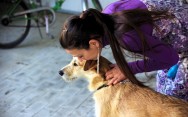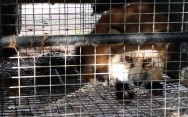Blog Archives
Home -
Posts tagged "Animal Cruelty" (Page 5)
The Bureau of Land Management’s brutal sterilization program for wild horses should not be allowed to take place. The plan calls for the least safe and most invasive method of sterilizing wild horses – even though controlling wild populations is already legally suspect (according to this op-ed).
The sterilization could hardly be called a procedure, as it involves vets literally reaching inside female horses for their ovaries and removing them right there on the spot. Without follow-up, a plan for administering antibiotics, pain relief, or a period of care, horses could hemorrhage or get sepsis and die out in the wild.
The BLM is ignoring other alternatives that could be safer, because of so-called cost, even though the scale of this sterilization program would be massive (and therefore costly) as well as the huge risk of failure. If the program is doomed to fail, it’s been suggested, it would be easier to justify mass cullings of horses by offering the excuse that other alternatives have failed. There is something callous and cynical about the sudden leap to board a large scale program that is not strongly backed by experts, that puts horses through so much unnecessary damage – without even giving pain relief.
Brutality is often justified by “necessity”. This program is crude, unnecessary and incredibly harmful to horses. Please sign the petition and share to protect wild horses.
Ghetto Rescue took one last video of Valerie the pitbull before she died, and it is heartbreaking. A blue-grey pitbull with a beautiful lustrous coat, she’s lying on the ground being reassured by the humans around her, as the life is ebbing out of her.
Ghetto Rescue found Valerie in South Los Angeles after she was dumped out of a car. They claim she was sexually assaulted, although her death seems to have been the result of trauma to her chest. The LAPD are investigating the case for bestiality and animal cruelty, and treating the sexual assault just as if it was a human rape (testing for DNA). The difference is however, that the rape is considered “bestiality” and is a misdemeanor rather than felony.
It’s reassuring to hear reports of the police going about their business in a thorough way, just as if Valerie was a human. The police started the investigation based on the posts of Ghetto Rescue. Still, Valerie’s abuse will have to be treated within the capacity of the law, which might not be enough to hold her abusers accountable. The sad thing is that this beautiful pitbull lost her life even though she was a shelter animal. Her chance for a new life ended tragically. Animals like Valerie are vulnerable to abuse, and protecting them ends up being a band-aid once they are seriously injured or traumatized. Rather than comforting them when they are dying, we need to take steps to protect them in life.
https://www.ocregister.com/2018/08/09/lapd-investigating-alleged-trauma-sexual-assault-of-pit-bull-found-in-south-los-angeles-area/
Because of a legal loophole, Japanese whalers can still kill large numbers of whales in the Antarctic every year, and this year, many pregnant and young whales were amongst the dead. Japan justifies these expeditions for scientific research, but their reasons are shaky.
For a start, the International Whaling Committee banned commercial whaling in 1985, and most countries, if not all, complied. A 1946 law that says whaling can still take place for scientific reasons is used as a justification for Japan’s expeditions. The whales on these expeditions can be sold for meat, leading to accusations that the scientific explanation is a convenient excuse. The scientific research is apparently undertaken to discover such factors as sexual maturity, nutritional condition and prey consumption of the whales. However critics have said this can be done by taking a biopsy instead. As well as claiming whale-hunting is done for scientific research, Japan has also defended its ancient “culture” of whaling.
122 pregnant whales and 114 juvenile whales died in this massacre. 333 whales in total were killed on this expedition. How did they die? By harpooning, ie using harpoons loaded with a 30g penthrite grenade.
Rather than terrorizing their population and using a violent method of killing them, Japanese whalers could find a more humane way of studying them, but they choose not to. Cultural inertia towards animals needs a wake-up call. Around the world, people are realizing that we don’t have to accept a cultural narrative about dominating and harming animals. It’s time to put pressure on the defenders of “cultural” cruelty to animals.
More info on this story:
https://www.nzherald.co.nz/world/news/article.cfm?c_id=2&objectid=12061465
https://www.bbc.com/news/world-asia-44307396
https://www.news.com.au/national/queensland/japan-whaling-kills-122-pregnant-whales-for-research/news-story/a1851aeec523563c79d593df7085e61b
Two teenagers from Wichita Falls are being charged with animal cruelty after they tortured and dismembered a kitten and shared the video on Snapchat. In response to the incident, PETA have launched a really important debate about teen animal cruelty. In a letter from their educational section, Teachkind, they pointed out that the dismemberment of the animal resembled lessons the teenagers were being taught in their science class.
Dissection teaches kids and teens that animals are disposable. PETA also cited numerous studies to show that dissection increases callousness towards animals in students. Once the capacity to be violent towards animals is established the links then blossom between violence to animals and violence to humans. You could argue that the Wichita Falls students are “bad examples” of humanity, or perhaps troubled, violent kids. But if so why did they choose to share their cruelty on Snapchat with their peers? Taking pride in animal cruelty assumes an audience for it. There is a context to this kind of behavior. Science class can teach a humane approach to doing science, or it can teach us that humans are “above” nature, and that we can take what we want from it. These girls used and tortured a defenseless kittens for their own reasons. Science education has a “purpose” for killing animals. And yet it sends the same message, that animals are disposable. There are plenty of methods of interactive learning available these days that can teach anatomy without dissection. Science increasingly doesn’t have to rely on cruelty. The right time to send the message of kindness is when minds are young and can be changed.
Please read, share and advocate for humane science education in schools!
For the original story, click on the link: https://www.timesrecordnews.com/story/news/local/2018/05/21/wichita-falls-video-kitten-being-abused-prompts-peta-response/629379002
If you list your pets for free on craigslist and other sites you could literally be in danger of delivering them to a serial killer. In South Dakota earlier this year, animal shelters circulated announcements warning people listing their animals that a cat serial killer was on the loose. Now a petition about a pitbull dog who was tortured and died has drawn attention to the fate of animals who are discarded through craigslist and other sites. This poor animal, known as “puppy doe”, was acquired through a “free to a good home” ad on Craigslist. The puppy was starved, beaten, stabbed, burned and her tongue sliced in two. She did not survive the cruelty.
If you’ve seen the petition about puppy doe you might be mistakenly thinking this is extraordinary, shocking animal cruelty. PETA unfortunately has another perspective. It receives routine reports of serial animal abusers who find their victims through ads (please see this “letter to the editor”). These animals are completely vulnerable to people who want to harm them, such as a Virginia man who pleaded guilty to torturing a dog he obtained through a craigslist ad. The dog was punched, her legs tied together, muzzled and set on fire while she was still alive.
It may be hard to believe, but animal cruelty is incredibly common. People can choose not to list their animals, but it would be even better if Craigslist could set a good example by stopping “free to a good home” ads for good. These ads leave animals in horrifyingly vulnerable positions, abandoned to human beings who can inflict untold suffering and abuse. This petition, started by ladyfreethinker.org, aims to put pressure on craigslist to stop this practice. Please sign and share!
In Thailand in recent months there has been a big debate about a policy called “set zero.” Even though Thailand’s rabies rate has dropped since the 1980s, there is a false conception that rabies is spreading at a high rate. To be clear, “set zero” can’t be described as anything other than canine and feline genocide. The only big idea behind this policy is to round up and kill as many dogs and cats as possible. Thailand does have a big problem with stray dogs and cats roaming free, it’s true, but “set zero” advocates euthanisation, for no good reason. The policy that has reduced the stray dog population and made the island of Phuket rabies-free is vaccination and sterilization.
The Soi Dog Foundation (the people behind the vaccinations and decrease of rabies in Phuket) are now highlighting an awful situation in which dogs and cats are being rounded up, and because they are packed in in close quarters, they are dying of disease. This situation is at breaking point. And Thailand is not the only country in which panics about infectious diseases causes mass culling, rather than thoughtful vaccination and sterilization programs. We are vulnerable to this thinking and these actions in the US too. It isn’t exaggerating to say that this is the same pattern that leads to genocide. With complete misunderstanding of the threat of rabies, a shadowy “enemy” has been created, and the cruel extermination of dogs and cats is seen as the “solution” to stamp out the evil. To act rationally and with compassion towards these animals is also to curb dangerous, violent tendencies within ourselves that could affect our fellow humans too.
Things you can do:
Educate your friends and neighbors about the importance of vaccinating all pets: https://www.americanhumane.org/fact-sheet/rabies-facts-prevention-tips/
Visit the Soi Dog Foundation website to see what you can do to help: https://www.soidog.org/
Just recently, a decomposed dog was found abandoned in a foreclosed home. We don’t know how long the animal suffered without food and water, but to have to deteriorate over the course of days would have been an incredibly painful end to the dog’s life. What’s maybe even worse though is the emotional distress the dog would have felt, abandoned by his owner and restrained so he couldn’t seek out food and water.
Legal chaining isn’t just a problem because people can cruelly abandon animals, it’s also a problem in cold and hot weather, or in any other situation where the dog’s life may be in danger so it can’t free itself. Dogs may be vulnerable to attack from other animals like coyotes or bears for example. Then there is the little-understood reality of what chaining is like for dogs psychologically. Chaining is stressful for dogs, and leads to aggressive behavior. According to a study by the Centers for Disease Control, chained dogs are 2.8 times more likely to bite than non-chained dogs. Jennifer Tierney of Fur-Ever Friends of North Carolina was quoted in this article stating that chaining is a “public health issue” for humans, too.
New laws are slowly being adopted, like Pennsylvania’s Libre Law, which limit chaining. Banning chaining altogether though would have the most beneficial effects for both humans and dogs. Chaining carries too much potential for abuse and emotional suffering – and sometimes plain old error. People who chain dogs habitually may simply forget to unchain them during extreme weather. Get informed about chaining by checking out some of the useful info the human society has on their website, and contact your local representative, to end this practice. For more information on the death of the brown Labrador who was abandoned, please follow the link to the petition: http://www.dogster.com/the-scoop/pennsylvania-stands-up-to-animal-cruelty
Sheep are worth a lot of money to the Australian economy. Specifically live sheep, shipped to the Middle East. Because of the volume of sheep shipped across the ocean, the industry even has a motto, “No fear, no pain.” Video camera footage shows that this is exactly the opposite of what the sheep experience on board these giant cargo ships. This and the testimony of trainee navigator Faisal Ullah has exposed the industry for the heartless and disposable way sheep are treated on their export voyages. During a 60 minutes program, we see dead sheep and lambs dumped overboard. Over the course of just one voyage 800 sheep were reported to have died on board due to heatstroke and were tossed overboard. The sheep are shown in obvious distress, panting, jammed close together and in a weakened state. Given that sheep spend weeks on board these voyages huddled close together, it seems unlikely that conditions on this ship could possibly be humane. The Chief Executive of the Australian Live Exporters Council, Simon Westaway argues in the 60 minutes program that this is merely an unfortunate, “isolated” case of abuse and standards not met. More likely, the volume of sheep and their value in bulk leads to the usual situation of animals being treated like “products”, rather than living individuals. The meat industry can try to clean up its act, but abuse often still seems to be the consequence of an industry that treats animals like disposable objects.
The 60 minutes report includes some disturbing scenes, but is well worth a watch: https://www.youtube.com/watch?v=m1V96Y533Ds
When we’re dealing with the oxymoron “Kill Shelter”, we may be shocked and disgusted at the way unwanted animals are disposed of. If an animal isn’t adopted after a few days from a Kill Shelter, the animal is killed. These overcrowded shelters are usually more like death-row for animals than the haven that the word “shelter” would suggest.
However we must be mindful that these shelters in themselves aren’t the reason why animals are being killed. As animal and pet-lovers we are part of the problem. It is our appetite for pure-bred pets that means underfunded shelters kill animals to reduce overcrowding. Puppy Mills are breeding factories that supply pet stores with puppies that were born and raised in conditions often unknown to the consumer or pet-store owner. Breeding dogs for profit is a cruel and pressured industry, where female dogs are forced to breed year after year. As well as the cruelty, the fall-out from this industry is that unwanted animals end up on the scrap-heap – where “kill shelters” take in animals and dispose of them when they can’t find a home for them.
So what can you do if you’re a dog lover?
The first thing to do is to adopt and to encourage others only to adopt rescue animals. Don’t buy from a pet-store or breeder as you will only be encouraging these industries.
You can also get involved in advocacy to raise awareness and fight against puppy mills. New York recently banned puppy mills, so legislators are waking up to the problem.
Here’s some more information from the ASPCA about puppy mills and why they are harmful to dogs: https://www.aspca.org/barred-from-love/how-avoid-cruelty/responsible-breeders
When mainstream publications like Fortune.com start publishing articles arguing for a meat tax, you know that something is in the air. Sweden, Denmark and Germany are calling for a meat tax. The American Institute for Cancer Research and the American College of Cardiology are in favor. The environmental costs of methane and soil erosion from the cattle industry are well known. Meanwhile, people are waking up to the horrible conditions that animals suffer in factory farms. The article also points out how much damage the meat industry does in its production phase even before animal products go into people’s bodies. Air and water pollution from meat production predominantly affects people unfortunate enough to live within range (usually lower income people, who are often people of color).
When we treat the environment, animals or other human beings as dehumanized products, there are always consequences for individual and collective wellbeing. Cruelty has been sold as self-interest when in fact it is quite the opposite – it undermines whole environmental systems and deprives us of our potential to peacefully co-exist with animals.
http://fortune.com/2018/02/20/meat-tax-climate-change-health-us/








Social Media